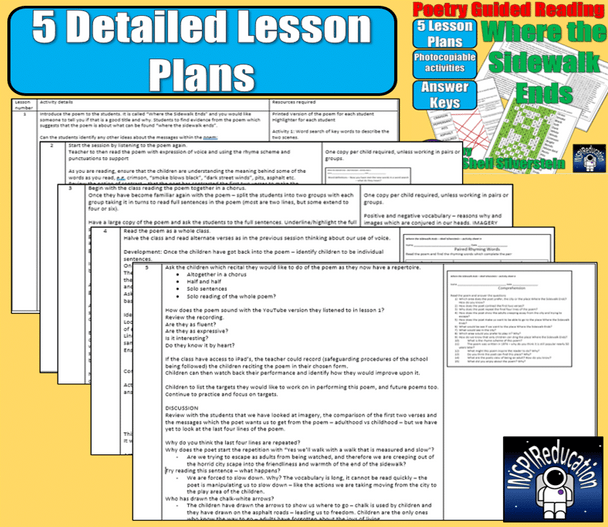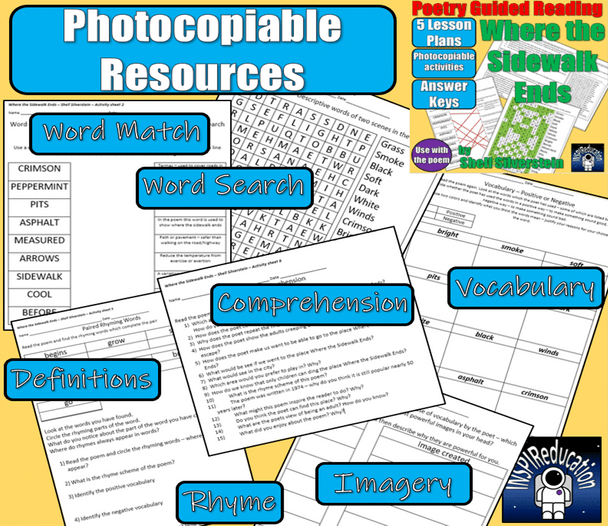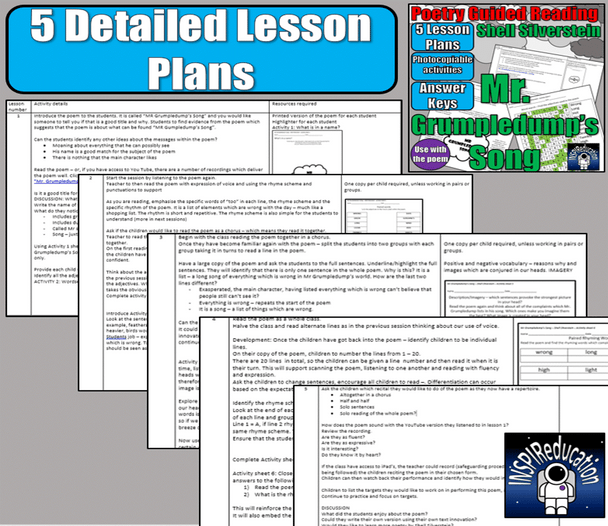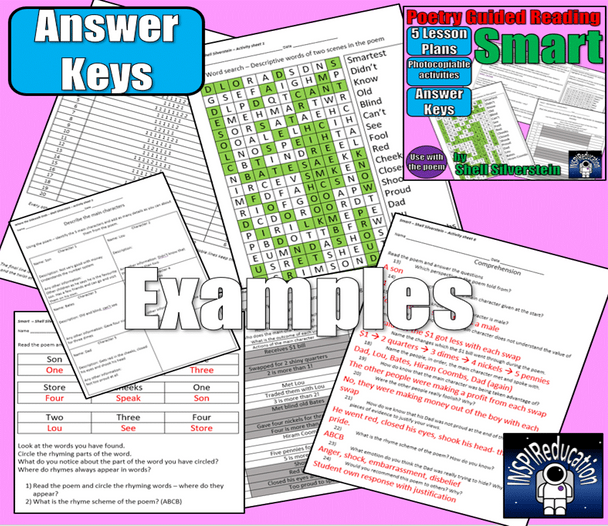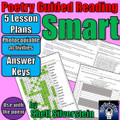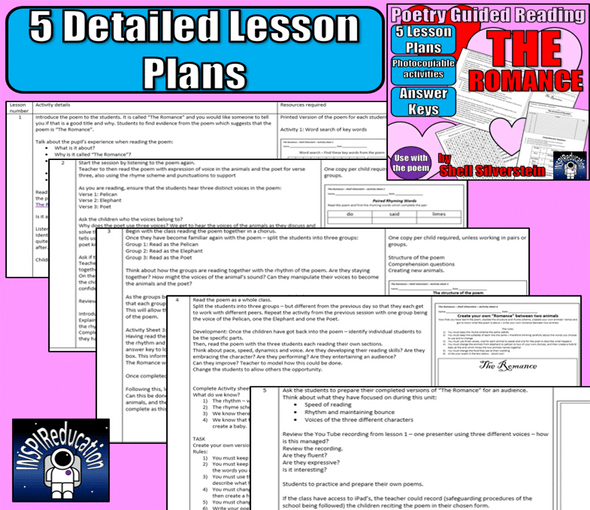Description
This bundle brings together our popular Poetry Guided Reading Lesson Plans linked to the poet Shell Silverstein. Each product takes one week (5 lessons) to deliver to students in 4th, 5th and 6th Grade and teaches the following skills:
- Imagery within specific poems
- Rhyme, Rhythm and structure of the poems
- Inference and deduction
- Humor in poetry
- Ability to read in a chorus, paired or independently
- Links to the poet reading their own work, and investigating how poetry recital can be improved
Each product contains the following resources:
- 5 daily, detailed lesson plans (including teaching points, what to look out for, what questions to ask and the answers to gain in order to interrogate the poems fully with students)
- 6 photocopiable resources
- Answer Key for all photocopiable resources
We are continuing to add to this growing bundle, but included currently are the following poems:
- Smart
- Where the Sidewalk Ends
- Mr Grumpledump's Song
For more details on each poetry pack - see below:
Smart
This product has been developed as part of a week long Guided Reading Unit using the poem:
"Smart" by Shel Silverstein (not included in the resource but readily available)
In the poem, the poet describes the journey of a "favourite son" given $1 by his Dad and then begins swapping the dollar for amounts he believes to be more and making a massive profit - in fact, the denominations become smaller and smaller - ending with a great response from the boy's Dad!
We have put together our 5 detailed lesson plans which include notes on how to introduce the poem using a You Tube clip - the link is included in the teaching plans, before reading it yourself. The children therefore hear a professional recital of the poem and understand how fluency, pace and expression should be used.
Included in this product:
- 5 day, detailed lesson plan identifying how to teach the reading of the poem and links with specific resources included and when/how to use them.
- 6 photocopiable resources for the class to use
- Answer Key for each activity where it is needed (one activity is student response to imagery where they share how they respond to specific vocabulary within the poem, therefore no answer key is provided for this activity.
Over the five lessons, the development of the reading of the poem is clear:
Day 1: Hear the poem for the first time, read it aloud together, trying to keep together
Day 2: Continue to practice the poem, adding in expression for the different, contrasting main verses of childhood play and adult responsibility - this also develops language knowledge too.
Day 3: Develop a chorus and split the group into two separate roles
Day 4: Group chorus to be developed further and individual children reading sections and finally, the whole poem with fluency and expression
Day 5: Work through the repertoire which the children now have - group performance, solo and group chorus. Day 5 also includes opportunities for assessment and target setting to reflect on next steps in learning.
Each day, not only do the children learn how to read, recite and perform poetry through a range of activities, but they get to know the poem in greater depth by completing 6 activities:
- Activity 1: Word search identifying new vocabulary - descriptions and names of the 5 characters within the poem
- Activity 2: Rhythm of the poem, counting syllables, looking for patterns
- Activity 3: Describing the main characters and inferring what we know about them
- Activity 4: Plotting the poem - the journey of the son and the changes made to the $1
- Activity 5: Rhyme Scheme, Poetry observation - questions about the poem
- Activity 6: Comprehension questions and review of learning and discussions through the five lessons
Each activity has its' own answer key, and can form part of the lesson, as it dictated in the lesson plan, or can be provided as a home based activity, early morning activity, early finisher, or Literacy Center activity.
Where the Sidewalk Ends
This product has been developed as part of a week long Guided Reading Unit using the poem:
"Where the Sidewalk Ends" by Shel Silverstein (not included in the resource but readily available)
In the poem, the poet describes a secret play-place which only children can find. It enables them to escape the smog and smoke of the city and play with excitement in an incredible place! It contrasts the life of adulthood with childhood - and implores children as they grow up to always find the time to play and balance their lives - a fantastic message for students today!
We have put together our 5 detailed lesson plans which include notes on how to introduce the poem using a You Tube clip - the link is included in the teaching plans, before reading it yourself. The children therefore hear a professional recital of the poem and understand how fluency, pace and expression should be used.
Included in this product:
- 5 day, detailed lesson plan identifying how to teach the reading of the poem and links with specific resources included and when/how to use them.
- 6 photocopiable resources for the class to use
- Answer Key for each activity where it is needed (one activity is student response to imagery where they share how they respond to specific vocabulary within the poem, therefore no answer key is provided for this activity.
Over the five lessons, the development of the reading of the poem is clear:
Day 1: Hear the poem for the first time, read it aloud together, trying to keep together
Day 2: Continue to practice the poem, adding in expression for the different, contrasting main verses of childhood play and adult responsibility - this also develops language knowledge too.
Day 3: Develop a chorus and split the group into two separate roles
Day 4: Group chorus to be developed further and individual children reading sections and finally, the whole poem with fluency and expression.
Day 5: Work through the repertoire which the children now have - group performance, solo and group chorus. Day 5 also includes opportunities for assessment and target setting to reflect on next steps in learning.
Each day, not only do the children learn how to read, recite and perform poetry through a range of activities, but they get to know the poem in greater depth by completing 6 activities:
- Activity 1: Word search identifying new vocabulary - contrasting styles used within the poem
- Activity 2: Linking new vocabulary to its definition
- Activity 3: Positive and negative used of vocabulary
- Activity 4: Exploring imagery within language
- Activity 5: Rhyme Scheme, Poetry observation - questions about the poem
- Activity 6: Comprehension questions and review of learning and discussions through the five lessons
Each activity has its' own answer key, and can form part of the lesson, as it dictated in the lesson plan, or can be provided as a home based activity, early morning activity, early finisher, or Literacy Center activity.
Mr Grumbledump's Song
This product has been developed as part of a week long Guided Reading Unit using the poem:
"Mr Grumpledump's Song" by Shel Silverstein (not included in the resource but readily available)
In the poem, the poet describes the feelings of the main character towards all the things he comes across on a particularly lovely and perfect day - although he feels everything is just wrong! Great for focusing on the use of language in charcters names, nouns and adjective use within poetry too.
We have put together our 5 detailed lesson plans which include notes on how to introduce the poem using a You Tube clip of the poem - the link is included in the teaching plans, before reading it yourself. The students therefore hear a professional recital of the poem and understand how fluency, pace and expression should be used.
Included in this product:
- 5 day, detailed lesson plan identifying how to teach the reading of the poem and links with specific resources included and when/how to use them.
- 6 photocopiable resources for the class to use
- Answer Key for each activity where it is needed (one activity is student response to imagery where they share how they respond to specific vocabulary within the poem, therefore no answer key is provided for this activity).
Over the five lessons, the development of the reading of the poem is clear:
Day 1: Hear the poem for the first time, read it aloud together, trying to keep together
Day 2: Continue to practice the poem, adding in expression for the different, contrasting main verses of childhood play and adult responsibility - this also develops language knowledge too.
Day 3: Develop a chorus and split the group into two separate roles
Day 4: Group chorus to be developed further and paired students reading the poem through a call and response structure - provided by the poem.
Day 5: Work through the repertoire which the students now have - group performance, paired and group chorus. Day 5 also includes opportunities for assessment and target setting to reflect on next steps in learning.
Each day, not only do the students learn how to read, recite and perform poetry through a range of activities, but they get to know the poem in greater depth by completing 6 activities:
- Activity 1: What is in a name - exploring the features within the name Mr Grumpledump's Song and discussing why it adds so much more to the poem by having such a great main character name
- Activity 2: Word search identifying the adjectives within the poem
- Activity 3: Linking nouns to adjectives
- Activity 4: Turning a negative into a positive
- Activity 5: Imagery created within poetry
- Activity 6: Rhyme Scheme and comprehension skills (inference focus)
Each activity has its' own answer key, and can form part of the lesson, as it dictated in the lesson plan, or can be provided as a home based activity, early morning activity, early finisher, or Literacy Center activity.
Best wishes
INSPIReducation



